Main menu
Common skin conditions

NEWS
Join DermNet PRO
Read more
Quick links
Generalised eruptive keratoacanthomas — extra information
Generalised eruptive keratoacanthomas
Authors: Katrina Tan, Medical Student, Monash University, Australia; Dr Martin Keefe, Dermatologist and Assistant Editor, New Zealand; January 2022. Previous author: A/Prof Amanda Oakley, Dermatologist, Waikato Hospital, Hamilton, New Zealand 2004. Copy edited by Gus Mitchell.
Introduction
Demographics
Causes
Clinical features
Variation in skin types
Complications
Diagnosis
Differential diagnoses
Treatment
Outcome
What are generalised eruptive keratoacanthomas?
Generalised eruptive keratoacanthoma of Grzybowski, also known as Grzybowski syndrome, is a rare variant of keratoacanthoma characterised by the presence of hundreds to thousands of keratoacanthoma-like papules scattered on the skin and mucous membranes.
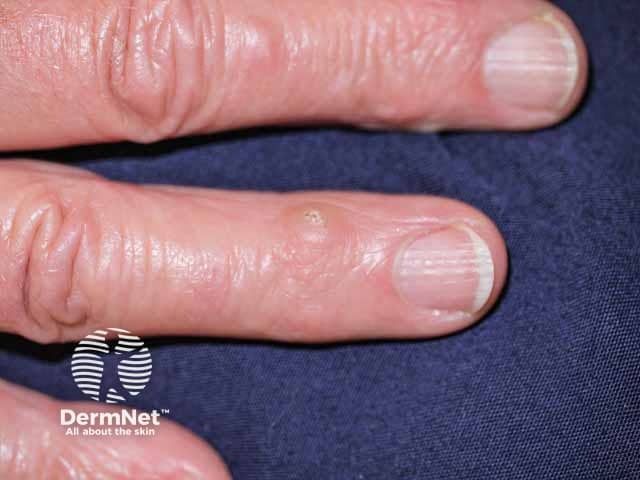
Domed papule on the finger with the typical central plug in generalised eruptive keratoacanthomas (GEKA-patient3)
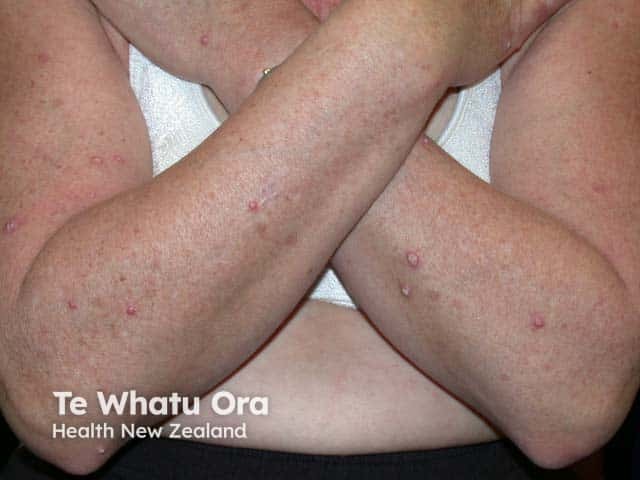
Crateriform papules on the arms in generalised eruptive keratoacanthomas (GEKA-patient1)
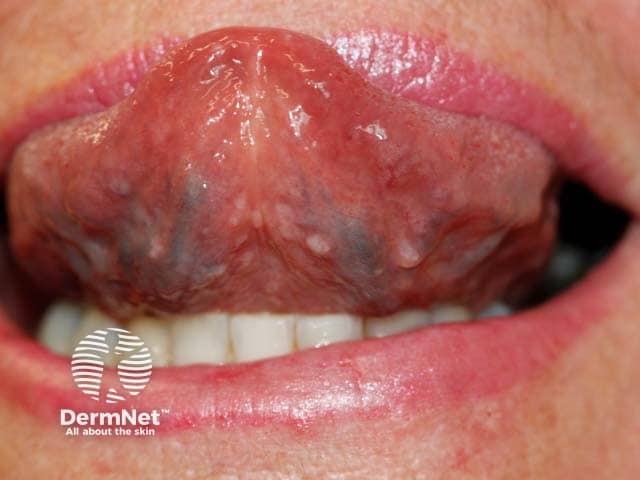
White papular lesions on the tongue in a woman with generalised eruptive keratoacanthomas
Who gets generalised eruptive keratoacanthomas?
Generalised eruptive keratoacanthoma is a very rare disease. It was first described in 1950 and around 40 cases have been reported since.
- Age: predominantly in patients aged 40–70 years.
- Sex: no preference for either sex is demonstrated.
- Skin type: most cases have been reported in patients with fairer skin.
- Genetics: no familial tendency has been noted.
What causes generalised eruptive keratoacanthomas?
The cause of generalised eruptive keratoacanthomas is not completely understood but they have been associated with:
- Human papillomavirus infection, although there is no consistency and causality has not been established
- Ultraviolet radiation — given the predilection for lesions to occur on sun-exposed skin
- Chemical carcinogens (e.g. turf paper, tar)
- Radiation
- Immunosuppression
- BRAF (eg, vemurafenib and dabrafenib) and hedgehog inhibitors (eg, vismodegib)
- Skin trauma leading to Koebnerisation
- Underlying dermatoses such as psoriasis
- Autoimmune diseases such as Sjogren syndrome and polyarthritis/arthritis medication (leflunomide).
What are the clinical features of generalised eruptive keratoacanthomas?
Generalised eruptive keratoacanthomas present as a sudden or progressive eruption of hundreds to thousands of small (1–5mm), pruritic, umbilicated, skin-coloured to erythematous papules, with a central keratotic plug.
They predominantly affect sun-exposed areas, such as the face and upper trunk, but also have a particular predilection for the intertriginous areas and may be seen on the tongue, the buccal mucosa, and the larynx.
Lesions on the face may be extensive. Confluent periorbital keratoacanthomas may produce a mask-like appearance, known as the sign of Zorro.
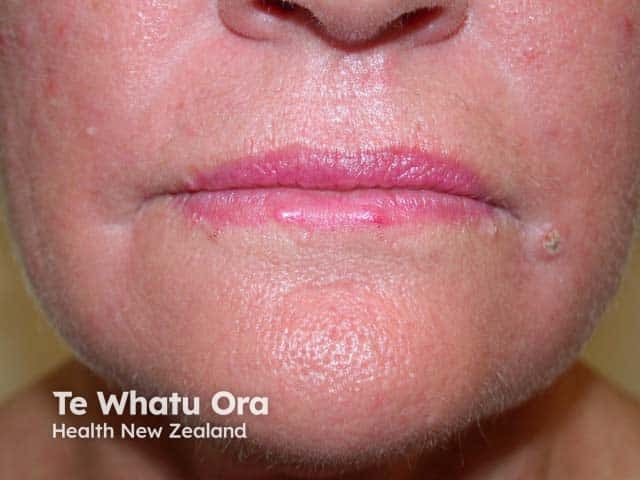
Domed, centrally plugged papules on the face in generalised eruptive keratoacanthomas (GEKA-patient1)
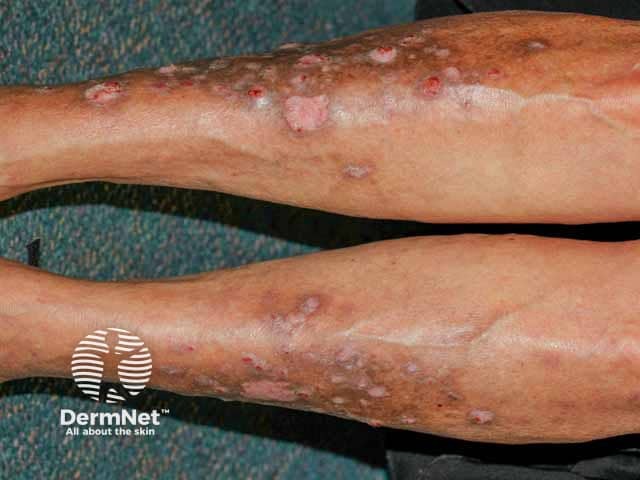
Hyperkeratotic lesions on the legs in generalised eruptive keratoacanthomas (GEKA-patient2)
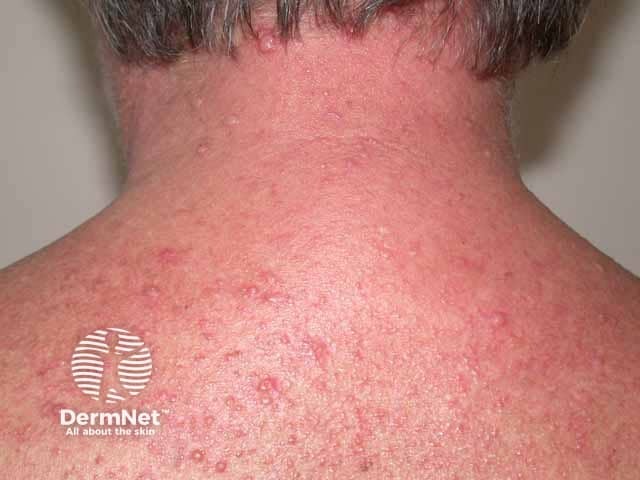
Multiple domed 3-5 mm plugged papules in generalised eruptive keratoacanthomas (GEKA-patient7)
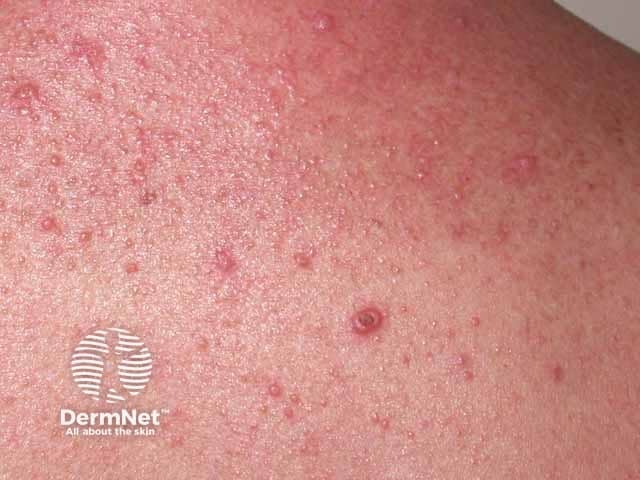
Multiple domed 3-5 mm plugged papules in generalised eruptive keratoacanthomas (GEKA-patient7)
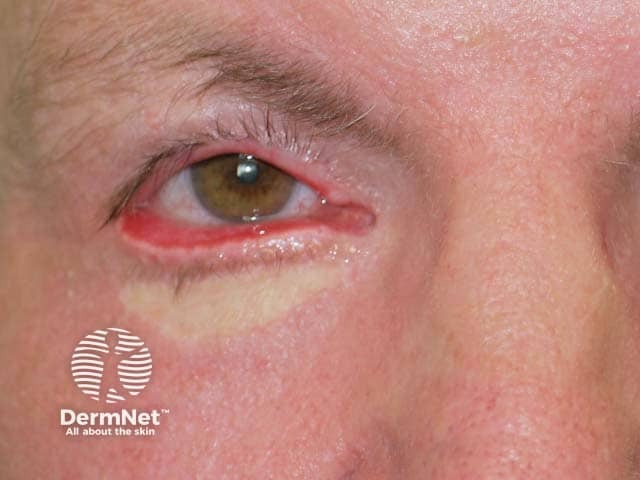
Ectropion due to GEKA (GEKA-patient3)
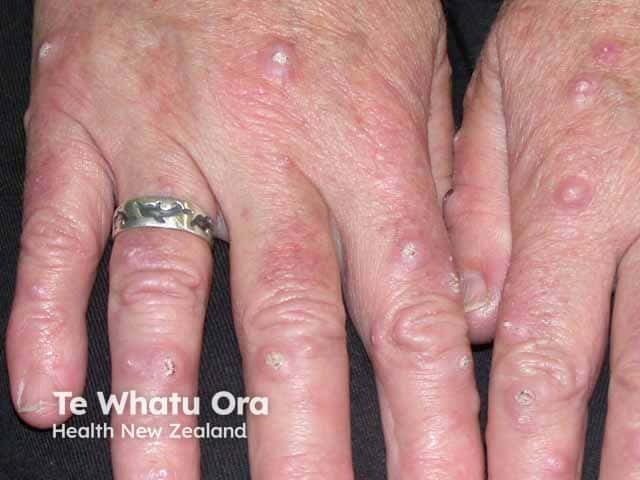
Crateriform hand papules in GEKA (GEKA-patient1)
How do clinical features vary in differing types of skin?
Generalised eruptive keratoacanthomas have been described in patients of all skin phototypes.
What are the complications of generalised eruptive keratoacanthoma?
Generalised eruptive keratoacanthoma is a chronic, progressive disease associated with significant morbidity:
- Intense pruritus which impairs quality of life
- Masked facies
- Cicatricial ectropion, which rarely has caused total blindness
- An association with internal malignancy has occasionally been reported but may be coincidental.
How are generalised eruptive keratoacanthomas diagnosed?
The diagnosis is established based on the clinical features and typical histology showing a crater-shaped squamoproliferative lesion with atypical keratinocytes with a central keratin plug similar to a solitary keratoacanthoma.
What is the differential diagnosis for generalised eruptive keratoacanthomas?
- Pseudoepitheliomatous hyperplasia
- Well-differentiated squamous cell carcinomas
- Multiple self-healing epitheliomas of Ferguson-Smith
- Familial keratoacanthomas of Witten and Zak
What is the treatment for generalised eruptive keratoacanthomas?
Treatment for generalised eruptive keratoacanthoma is unsatisfactory. The number, extent, and location of the tumours render treatment difficult.
General measures
Specific measures
The most effective and most practical treatment may be oral acitretin.
Treatments that may be considered include:
-
Oral acitretin
-
Surgical excision and physical destruction (although often impractical due to the sheer number of lesions and risk of Koebnerisation)
-
Topical therapy:
- 5-fluorouracil
- Podophyllin
- Tretinoin
- Imiquimod
- Lapacho tea wraps
- Photodynamic therapy
-
Intralesional therapy:
- Bleomycin
- 5-fluorouracil
- Methotrexate
- Triamcinolone
-
Other systemic therapies:
- Cyclophosphamide
- Gamma-interferon
- Alpha-interferon
- Methotrexate
- Isotretinoin
What is the outcome for generalised eruptive keratoacanthoma?
Generalised eruptive keratoacanthomas are frequently progressive and chronic. Treatment is often unsatisfactory. Malignant change has not been reported.
References
- Abbas MN, Tan WS, Kichenadasse G. Sorafenib-related generalized eruptive keratoacanthomas (Grzybowski syndrome): a case report. J Med Case Rep. 2021;15(1):481. doi:10.1186/s13256-021-03037-4. Journal
- Anzalone CL, Cohen PR. Generalized eruptive keratoacanthomas of Grzybowski. Int J Dermatol. 2014;53(2):131–6. doi:10.1111/ijd.12318. Journal
- Consigli JE, Gonzalez ME, Morsino R, et al. Generalised eruptive keratoacanthoma (Grzybowski variant). BJD. 2001; 142:800-803. doi:10.1046/j.1365-2133.2000.03430.x. Journal
- Havenith R, de Vos L, Fröhlich A, et al. Grzybowski's Generalized Eruptive Keratoacanthomas in a Patient with Terminal Kidney Disease-An Unmet Medical Need Equally Ameliorated by Topical Imiquimod Cream and Lapacho Tea Wraps: A Case Report. Dermatol Ther (Heidelb). 2021;11(2):625–38. doi:10.1007/s13555-021-00502-2. Journal
- Kavanagh GM, Marshman G, Hanna MM. A case of Grzybowski's generalized eruptive keratoacanthomas. Australas J Dermatol. 1995;36(2):83-85. doi:10.1111/j.1440-0960.1995.tb00938.x. Journal
- Liu LQ, Jiao T, Wang JY. Irreversible blindness in generalised eruptive keratoacanthoma of Grzybowski. Clinical and Experimental Dermatology. 2021; 46(7): 1376–8. doi: 10.1111/ced.14702. Journal
- Mascitti H, De Masson A, Brunet-Possenti F, et al. Successful Treatment of Generalized Eruptive Keratoacanthoma of Grzybowski with Acitretin. Dermatol Ther (Heidelb). 2019;9(2):383–8. doi:10.1007/s13555-019-0287-0. Journal
- Mlacker S, Kaw U, Maytin EV. Use of photodynamic therapy and acitretin in generalized eruptive keratoacanthoma of Grzybowski. JAAD Case Rep. 2017;3(5):457–9. Published 2017 Sep 8. doi:10.1016/j.jdcr.2017.06.013. PubMed
- Nofal A, Assaf M, Ghonemy S, et al. Generalised eruptive keratoacanthoma: a diagnostic and therapeutic challenge. Int J Dermatol. 2014;54(2):160–7. doi: 10.1111/ijd.12308. Journal
- Norgauer J, Rohwedder A, Schaller J, et al. Human Papillomavirus and Grzybowski’s generalised eruptive keratoacanthoma. J Am Acad Dermatol. 2003; 49(4): 771–2. doi: 10.1067/S0190-9622(03)01676-1. Journal
On DermNet
Other websites
- Keratoacanthoma: Epidemiology, risk factors, and diagnosis — UpToDate
- Generalised eruptive keratoacanthoma — Rare Disease InfoHub
